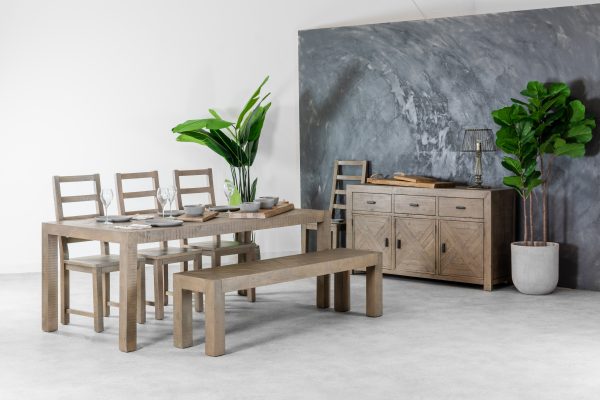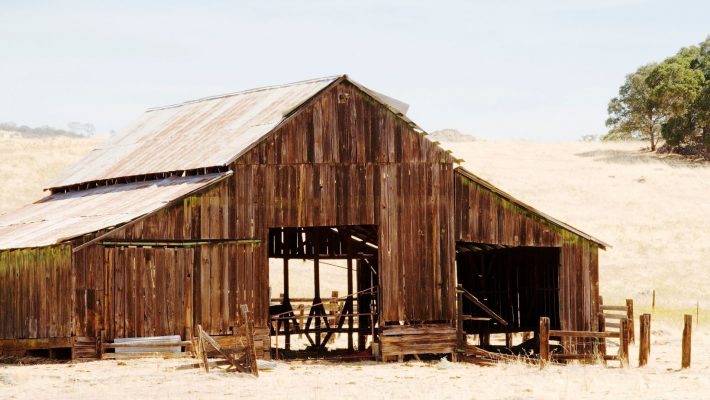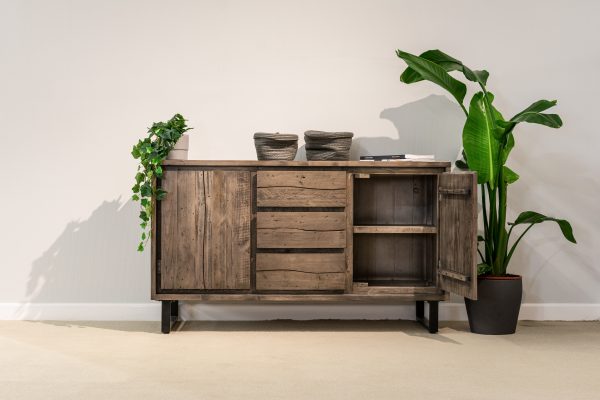Reclaimed wood has become a highly sought-after material in recent years, known for its unique aesthetic and sustainable qualities. But what exactly is reclaimed wood? Reclaimed wood is timber that has been previously used in the construction of buildings, furniture, or other structures and is repurposed for new uses. This type of wood often comes from old barns, factories, warehouses, and even ships, giving it a rich history and distinct character that new wood simply cannot replicate.
The purpose of this article is to delve into the various sources of reclaimed wood and highlight the numerous benefits of incorporating it into your furniture business. From environmental advantages to its unique appearance, reclaimed wood offers a range of compelling reasons for its growing popularity. By understanding where reclaimed wood comes from and why it is a valuable resource, you can make informed decisions about using this sustainable material in your retailer furniture business. Whether you’re a retailer looking to add rustic charm to your inventory or a business aiming for eco-friendly practices, reclaimed wood is an excellent choice that combines history, beauty, and sustainability.

Understanding Reclaimed Wood
Definition and Characteristics of Reclaimed Wood: Reclaimed wood is timber that has been salvaged from old structures such as barns, factories, warehouses, and even ships, and repurposed for new uses. Unlike new wood, reclaimed wood has a unique appearance marked by its weathered texture, nail holes, and patina, which adds character and history to any piece. The wood is typically sourced from old-growth trees, making it denser and more durable than many types of new wood available today. This density and strength make reclaimed wood an excellent material for a variety of applications.
Historical Context and Traditional Uses: Historically, reclaimed wood was commonly used out of necessity during times when resources were scarce. Structures were built to last, and when they outlived their original purposes, the wood was repurposed rather than discarded. This practice was particularly prevalent in rural areas where barns and farmhouses provided a plentiful supply of reusable wood. Traditional uses of reclaimed wood included constructing new buildings, crafting furniture, and even creating tools and household items. The inherent durability and quality of the wood meant that it could withstand the test of time and multiple uses.
Modern Applications in Various Industries: Today, reclaimed wood has found its way into modern applications across various industries, driven by both its aesthetic appeal and environmental benefits. In the furniture industry, reclaimed wood is prized for creating one-of-a-kind pieces that stand out due to their unique textures and histories. From rustic dining tables to chic coffee tables, reclaimed wood adds a touch of authenticity and charm to any furniture item. In construction, reclaimed wood is used for flooring, beams, and paneling, offering a sustainable alternative to new timber. Additionally, reclaimed wood is popular in interior décor, where it is used to craft accent walls, shelves, and decorative items that bring a sense of warmth and character to spaces.
By understanding the definition, historical context, and modern applications of reclaimed wood, you can appreciate its value and potential for your furniture business. Embracing reclaimed wood not only supports sustainable practices but also allows you to offer customers unique, high-quality products that tell a story.
Sources of Reclaimed Wood
Old Barns and Farmhouses: Old barns and farmhouses are some of the most common and historically significant sources of reclaimed wood. These structures, often built during the 19th and early 20th centuries, are abundant in rural areas. The wood found in these buildings typically includes oak, pine, and chestnut, known for their durability and strength. The process of reclaiming wood from old barns and farmhouses involves careful deconstruction to preserve the integrity of the timber. Each piece is then cleaned, treated for pests, ensuring the wood is ready for modern use.

Factories and Warehouses: Industrial-era buildings, such as factories and warehouses, offer another rich source of reclaimed wood. These structures, often built in the late 1800s and early 1900s, were constructed with high-quality timbers like Douglas fir, longleaf pine, and oak. The wood from these buildings is typically dense and strong, having supported the weight and stress of industrial operations for decades. Using reclaimed wood from factories and warehouses not only provides a unique aesthetic but also supports sustainable practices by reducing the demand for new lumber. The process involves salvaging large beams and planks, which are then processed and repurposed for new applications.
Railroad Ties and Beams: Railroad ties and beams are known for their exceptional durability and unique aesthetic. These timbers have been treated to withstand heavy loads and harsh weather conditions, making them incredibly resilient. However, environmental considerations must be taken into account, as railroad ties are often treated with chemicals like creosote to preserve the wood. Reclaiming and repurposing railroad ties and beams require careful handling to ensure safety and environmental compliance. Despite these challenges, the distinctive appearance and strength of railroad wood make it a valuable material for modern projects.
Old Ships and Boats: Maritime wood, sourced from old ships and boats, is prized for its unique characteristics and durability. This wood has often been exposed to saltwater and varying weather conditions, giving it a distinctive patina and strength. Species commonly found in maritime applications include teak, mahogany, and oak. The preservation of wood from ships and boats over time is often superior due to the natural oils in the wood that resist rot and decay. In modern applications, reclaimed maritime wood is used to create stunning furniture, flooring, and decorative elements that bring a nautical touch to any space.

Urban Salvage Urban: salvage involves reclaiming wood from city demolitions and renovations. As cities evolve, many old buildings are taken down, providing a wealth of reclaimed wood opportunities. Common types of wood found in urban salvage include pine, oak, and maple, often sourced from old homes, commercial buildings, and even sidewalks. Urban reclaimed wood offers several advantages, including the diversity of wood types and the convenience of sourcing materials locally. This type of wood is often used in modern décor, adding a touch of urban history and sustainability to contemporary designs.
By exploring the various sources of reclaimed wood, such as old barns and farmhouses, factories and warehouses, railroad ties and beams, old ships and boats, and urban salvage, you can better understand the potential and benefits of using reclaimed wood in your furniture business. Embracing these sources not only supports environmental sustainability but also allows you to offer unique, high-quality products that stand out in the market.
Benefits of Using Reclaimed Wood
1. Environmental Benefits
- Sustainability and Forest Conservation: Reclaimed wood significantly contributes to sustainability by reducing the need for harvesting new timber. This practice helps preserve mature trees and maintain forest ecosystems.
- Waste Reduction: Using reclaimed wood decreases waste and landfill use. By repurposing wood from old structures, less material ends up in landfills, promoting a circular economy.
- Lower Carbon Footprint: Reclaimed wood has a lower carbon footprint in manufacturing. The energy required to reclaim, process, and transport it is often less than that needed for new wood production, resulting in reduced greenhouse gas emissions.
2. Aesthetic and Historical Value
- Unique Appearance: Each piece of reclaimed wood has a unique appearance and character, marked by weathered textures, nail holes, and rich patinas that new wood cannot replicate.
- Historical Significance: The historical value of reclaimed wood adds a layer of storytelling to any project. Wood from old barns, factories, or ships carries a history that can be incorporated into modern designs, providing a tangible connection to the past.
- Customizability: The uniqueness of reclaimed wood allows for highly customizable projects. Each piece can be tailored to create one-of-a-kind furniture or architectural features that stand out due to their distinctiveness.

3. Quality and Durability
- Superior Quality: Reclaimed wood is often superior in quality compared to new wood. Many sources are old-growth timber, which is denser and stronger than the younger trees commonly used today.
- Proven Durability: Reclaimed wood has already proven its durability by withstanding the test of time in its previous use. It is often more resistant to weathering and pests, having acclimated and adapted over the years, making it a reliable and enduring material for new applications.
4. Economic Benefits
- Cost Savings: In many cases, reclaimed wood can provide cost savings over new, high-quality wood. This is particularly true for old-growth timber, which would be more expensive if sourced new.
- Support for Local Businesses: Investing in reclaimed wood supports local businesses and artisans who specialize in reclaiming and repurposing wood, contributing to the local economy.
- Tax Benefits and Incentives: There may also be potential tax benefits and incentives for using sustainable materials in construction and manufacturing, further enhancing the economic appeal of reclaimed wood.
Incorporating reclaimed wood into your retailer furniture business can set you apart from competitors by offering products that are environmentally friendly, historically rich, and economically advantageous. This approach not only appeals to a growing market of sustainability-minded customers but also supports the preservation of our natural and historical resources.
Challenges and Considerations
1. Potential Issues with Reclaimed Wood
While reclaimed wood offers numerous benefits, it also comes with certain challenges and considerations that need to be addressed.
- Pests and Contamination: One of the primary concerns with reclaimed wood is the potential for pests and contamination. Wood that has been previously used in old structures may harbor insects such as termites or wood-boring beetles. Additionally, reclaimed wood can be contaminated with chemicals, paint, or other substances, depending on its previous use. For example, railroad ties are often treated with creosote, a toxic chemical preservative. Contamination can also occur from lead-based paints or asbestos in older buildings. These issues can pose health risks and compromise the integrity of the wood.
- Structural Weaknesses and Wear: Reclaimed wood may also have structural weaknesses and wear due to its age and prior usage. The wood may have cracks, splits, or other forms of damage that can affect its strength and durability. Over time, exposure to elements like moisture, heat, and physical stress can cause the wood to deteriorate. This wear and tear can result in compromised structural integrity, making it crucial to thoroughly inspect reclaimed wood before using it in new projects. Additionally, variations in wood dimensions and inconsistencies can make working with reclaimed wood more challenging than with new, uniformly cut timber.
2. Mitigation Strategies
Despite these potential issues, there are effective strategies to mitigate the challenges associated with reclaimed wood.
- Proper Inspection and Treatment: The first step in addressing the potential issues with reclaimed wood is to conduct a thorough inspection. This involves checking for signs of pest infestation, such as holes, sawdust, or insect activity. It also includes testing for contamination from chemicals or lead-based paints. Once inspected, the wood should be properly treated to eliminate any pests and remove contaminants. Treatments can include kiln drying to kill insects, sanding to remove surface contaminants, and using chemical treatments to neutralize toxins. Proper cleaning and finishing processes can also help restore the wood’s appearance and ensure its safety for use in new projects.
- Working with Professionals: Another effective mitigation strategy is to work with professionals who specialize in reclaimed wood. These experts have the knowledge and experience to identify potential issues and properly treat reclaimed wood. They can also provide valuable advice on selecting the best pieces for your specific project and ensuring that the wood meets all safety and quality standards. Professional services can include custom milling, dimensioning, and finishing, which can help address the inconsistencies and variations often found in reclaimed wood. By collaborating with professionals, you can ensure that the reclaimed wood used in your projects is both safe and durable.
- Collaborating with Specialized Suppliers: At Trendworld Furniture, we understand the importance of quality and sustainability. That’s why we collaborate with suppliers who specialize in reclaimed wood. These partnerships allow us to source high-quality reclaimed wood that has been carefully inspected and treated, ensuring that our products meet the highest standards of safety and durability. By working with specialized suppliers, we can offer our customers unique and sustainable furniture options that are both beautiful and environmentally friendly.
Using reclaimed wood in your furniture business demands careful attention to these challenges. However, with thorough inspection, proper treatment, and professional help, you can effectively leverage the unique advantages of this sustainable material. Utilizing reclaimed wood not only boosts the environmental and aesthetic appeal of your products but also demonstrates your dedication to quality and sustainability.
Buying Reclaimed Furniture from Trendworld Furniture
Purchasing reclaimed furniture from Trendworld Furniture offers numerous benefits that go beyond aesthetics. Our reclaimed wood products are not only environmentally friendly but also rich in history and character. By choosing reclaimed furniture, you contribute to sustainability and conservation efforts, while also adding a unique touch to your space.
Trendworld Furniture offers a variety of reclaimed wood products tailored for businesses. From rustic dining tables and stylish office desks to durable shelving and custom pieces, our collection is designed to meet the diverse needs of commercial environments. Each piece is crafted with care, ensuring both quality and durability.
We invite you to explore our collection of high-quality reclaimed wood furniture. Our team is dedicated to helping you find the perfect pieces that align with your business’s aesthetic and values. Contact Trendworld Furniture today to discover the beauty and benefits of incorporating reclaimed wood into your furniture offerings. Let us help you create a distinctive, sustainable, and stylish space that stands out.
